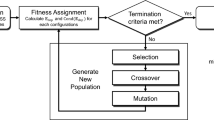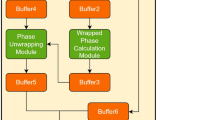Abstract
Purpose
The double-scattering Compton camera (DSCC) is a radiation imaging system that can provide both unknown source energy spectra and 3D spatial source distributions. The energies and detection locations measured in coincidence with three CdZnTe (CZT) detectors contribute to reconstructing emission energies and a spatial image based on conical surface integrals. In this study, we developed a digital data acquisition (DAQ) board to support our research into coincidence detection in the DSCC.
Methods
The main components of the digital DAQ board were 12 ADCs and one field programmable gate array (FPGA). The ADCs digitized the analog 96-channel CZT signals at a sampling rate of 50 MHz and transferred the serialized ADC samples and the bit and frame clocks to the FPGA. In order to correctly capture the ADC sample bits in the FPGA, we conducted individual sync calibrations for all the ADC channels to align the bit and frame clocks to the right positions of the ADC sample bits. The FPGA logic design was composed of IDELAY and IDDR components, six shift registers, and bit slip buffer resources.
Results
Using a Deskew test pattern, the delay value of the IDELAY component was determined to align the bit clock to the center of each sample bit. We determined the bit slip in the 12-bit ADC sample using an MSB test pattern by checking where the MSB value of one is located in the captured parallel data.
Conclusions
After sync calibration, we tested the interface between the ADCs and the FPGA with a synthetic analog Gaussian signal. The 96 ADC channels yielded a mean R2 goodness-of-fit value of 0.95 between the Gaussian curve and the captured 12-bit parallel data.









Similar content being viewed by others
References
Gambhir S. Molecular imaging of cancer with positron emission tomography. Nat Rev Cancer. 2002;2:683–93.
Kwon H, Becker A-K, Goo J, Cheon G. FDG whole-body PET/MRI in oncology: a systematic review. Nucl Med Mol Imaging. 2017;51:22–31.
Yoo I, Choi E, Chung Y. The current status of SPECT or SPECT/CT in South Korea. Nucl Med Mol Imaging. 2017;51:101–5.
Park S, Jung U, Lee S, Lee D, Kim C. Contrast-enhanced dual mode imaging: photoacoustic imaging plus more. Biomed Eng Lett. 2017;7:121–33.
Sajib S, Kwon O, Kim H, Woo E. Electrodeless conductivity tensor imaging (CTI) using MRI: basic theory and animal experiments. Biomed Eng Lett. 2018;8:273–82.
Todd R, Nightingale J, Everett D. A proposed gamma camera. Nature. 1974;251:132–4.
Singh M. An electronically collimated gamma camera for single photon emission computed tomography: part1 and 2. Med Phys. 1983;10:421–7.
Phillips G. Gamma-ray imaging with Compton cameras. Nucl Instr and Meth. 1995;99:674–7.
Jiang J, Shimazoe K, Nakamura Y, Takahashi H, Shikaze Y, Nishizawa Y, et al. A prototype of aerial radiation monitoring system using an unmanned helicopter mounting a GAGG scintillator Compton camera. J Nucl Sci Technol. 2016;53(7):1067–75.
Sato Y, Kawabata K, Ozawa S, Izumi R, Kaburagi M, Tanifuji Y, et al. Radiation imaging system using a Compton gamma-ray imager mounted on a remotely operated machine. IFAC PapersOnLine. 2017;50:1062–6.
Vetter K, Burks M, Cork C, Cunningham M, Chivers D, Hull E, et al. High-sensitivity Compton imaging with position-sensitive Si and Ge detectors. Nucl Instr and Meth. 2007;579:363–6.
Du Y, He Z, Knoll G, Wehe D, Li W. Evaluation of a Compton scattering camera using 3-D position sensitive CdZnTe detectors. Nucl Instr and Meth. 2001;457:203–11.
Watanabe S, Tanaka T, Oonuki K, Mitani T, Takeda S, Kishishita T, et al. Development of CdTe pixel detectors for Compton cameras. Nucl Instr and Meth. 2006;567:150–3.
Wulf E, Phlips B, Johnson W, Kurfess J, Novikova E. Thick silicon strip detector Compton imager. IEEE Trans Nucl Sci. 2004;51:1997–2003.
Yang Y, Gono Y, Motomura S, Enomoto S, Yano Y. A Compton camera for multitracer imaging. IEEE Trans Nucl Sci. 2001;48:656–61.
Motomura S, Enomoto S, Haba H, Igarashi K, Gono Y, Yano Y. Gamma-ray Compton imaging of multitracer in biological samples using strip germanium telescope. IEEE Trans Nucl Sci. 2007;54:710–7.
Motomura S, Kanayama Y, Haba H, Watanabe Y, Enomoto S. Multiple molecular simultaneous imaging in a live mouse using semiconductor Compton camera. J Anal At Spectrom. 2008;23:1089–92.
Seo H, Kim C, Park J, Kim J, Lee J, Lee C, et al. Multitracing capability of double-scattering Compton imager with NaI(Tl) scintillator absorber. IEEE Trans Nucl Sci. 2010;57:1420–5.
Peterson S, Robertson D, Polf J. Optimizing a three-stage Compton camera for measuring prompt gamma rays emitted during proton radiotherapy. Phys Med Biol. 2010;55:6841–56.
Richard M-H, Chevallier M, Dauvergne D, Freud N, Henriquet P, Le Foulher F, et al. Design guidelines for a double scattering Compton camera for prompt-γ imaging during ion beam therapy: a Monte Carlo simulation study. IEEE Trans Nucl Sci. 2011;58:87–94.
Kamea T, Enomoto R, Hanada N. A new method to measure energy, direction, and polarization of gamma-rays. Nucl Inst Methods Phys Res A. 1987;260:254–7.
Kamea T, Hanada H. Prototype design of multiple Compton gamma-ray camera. IEEE Trans Nucl Sci. 1988;35:352–5.
Dogan N, Wehe DK, Knoll GF. Multiple Compton scattering gamma ray imaging camera. Nucl Inst Methods Phys Res A. 1990;299:501–6.
Smith B. Reconstruction methods and completeness conditions for two Compton data models. J Opt Soc Am A. 2005;22:445–59.
Kim S, Lee J, Lee C, Kim C, Lee M, Lee D, et al. Fully three-dimensional OSEM-based image reconstruction for Compton imaging using optimized ordering schemes. J Opt Soc Am A Opt Image Sci Vis. 2010;55:5007–27.
Kim S, Seo H, Park J, Kim C, Lee C, Lee S-J, et al. Resolution recovery reconstruction for a Compton camera. Phys Med Biol. 2013;58:2823–40.
Ko G, Yoon H, Kwon S, Hong S, Lee D, Lee J. Development of FPGA-based coincidence units with veto function. Biomed Eng Lett. 2011;1:27–31.
ADS5281 Analog-to-Digital Converter (ADC). TI.com. http://www.ti.com/product/ADS5281 of subordinate document. Accessed 24 Aug 2018.
Artix-7 FPGA Family. Xilinx.com. http://www.xilinx.com/products/silicon-devices/fpga/artix-7.html#productTable of subordinate document. Accessed 24 Aug 2018.
Funding
The authors would like to gratefully acknowledge the financial support by the Nuclear R&D Program of the Ministry of Science, the ICT & Future Planning (MSIP) of South Korea (NRF-2013M2A2A4023359), and research grants from Korea Institute of Ocean Science and Technology (PE99672).
Author information
Authors and Affiliations
Corresponding author
Ethics declarations
Conflict of Interest
Soo Mee Kim and Young Soo Kim declare that they have no competing interests.
Ethical Approval
This article does not contain any studies with human participants or animals performed by any of the authors.
Rights and permissions
About this article
Cite this article
Kim, S.M., Kim, Y.S. FPGA-Based Interface of Digital DAQ System for Double-Scattering Compton Camera. Nucl Med Mol Imaging 52, 430–437 (2018). https://doi.org/10.1007/s13139-018-0551-8
Received:
Revised:
Accepted:
Published:
Issue Date:
DOI: https://doi.org/10.1007/s13139-018-0551-8




